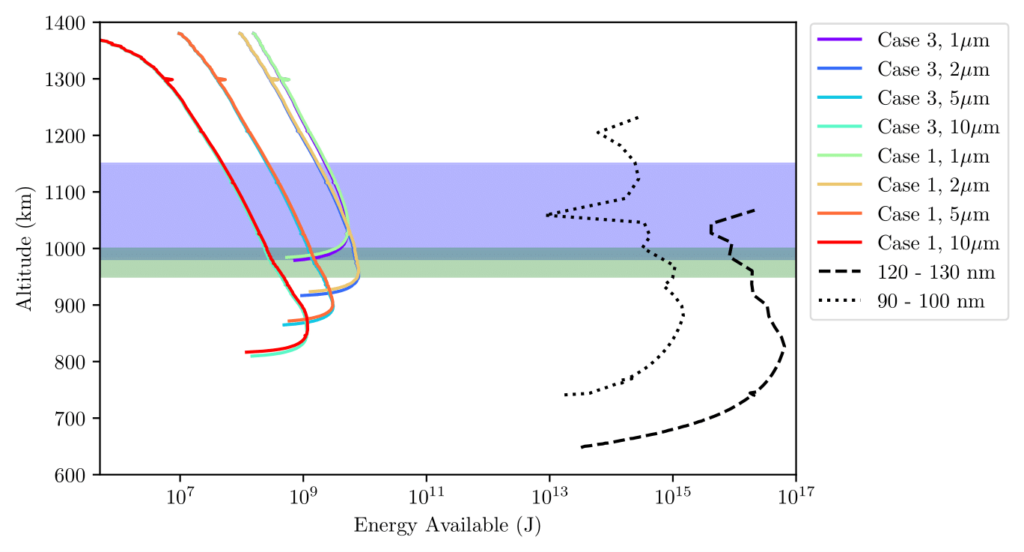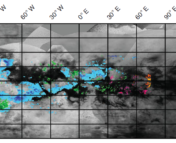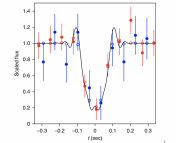Title: Energy Delivery via Meteors into Titan’s Atmosphere
Authors: Erin E. Flowers, Christopher F. Chyba, Paul J. Thomas
First Author’s Institution: Princeton University
Status: Submitted to Elsevier, available on arXiv
The Cassini-Huygens mission provided huge insight into Titan, Saturn’s largest moon, best known for its hazy atmosphere. But, the mission also uncovered mysteries that are still to be solved. Among them include anomalies in the composition of Titan’s atmosphere, where instruments on Cassini discovered unexpected methane and hydrogen abundances. The Ion Neutral Mass Spectrometer (INMS) and the Composite Infrared Spectrometer (CIRS) instruments found that there is more H2 in deeper layers of the atmosphere than predicted, while at certain altitudes, the amount of CH4 is lower than expected. The causes of neither of these anomalies are fully understood, but could they potentially be explained by the materials and energy deposited by meteors that enter Titan’s atmosphere?
As meteors enter Titan’s atmosphere, they begin to break up, depositing their constituent materials into the atmosphere and transferring their kinetic energy. This additional energy could help to kickstart chemical reactions which cause the anomalies! The authors of today’s paper therefore investigate just that, updating and correcting previous models of meteor entry into Titan’s atmosphere for a variety of cases to develop a picture of how much energy might be being added to the system.
Modelling Meteors
Using the numerical Runge-Kutta method, the authors tested different modelling set-ups, changing the mass and entry angle of the icy, hydrogen-rich, Kuiper belt dust that makes up the majority of the meteors around Saturn. The meteors in the model impact the atmosphere at speeds between 2-18 km/s, taking into account the relative velocity of Titan as it orbits Saturn, and are assumed to maintain a constant path through the atmosphere.

As seen in Figure 1, meteors with different entry angles and masses deposit varying amounts of energy as they fall through the atmosphere and are slowly destroyed. The smallest sets of particles (the purple and blue colours on the left of Figure 1, and which have varying entry angles on the right) are perhaps the most interesting, as they deposit the majority of their molecular make-up and energy in the same regions of Titan’s atmosphere where the H2 and CH4 anomalies are observed! Importantly, measurements from New Horizons and Pioneer 10 suggest that these tiny particles make up the majority of the population of meteors at the orbit of Saturn, so large numbers of these meteors should be hitting Titan each year.
Adding It All Up
By considering the total meteor flux at Titan, the authors calculate the total kinetic energy deposited into the atmosphere for the smallest four masses over the course of one Saturn year (or 29 normal years for those of us that live on Earth), as they make up the bulk of meteorite energy deposition. They then compare these values to the total energy deposited by solar UV photons, which are the main external source of energy in Titan’s atmosphere, as shown in Figure 2.

While the UV photons (shown in dotted lines for two wavelength regions) provide more total energy, the meteorites are more significant at higher altitudes, as well as at night when there is no solar radiation hitting Titan. Here, the authors also test the impact of a changing trajectory through the atmosphere and find that while the meteors survive slightly longer and reach deeper into the atmosphere, the difference in the energy deposited is minimal.
Could the micrometeors be responsible for the H2 and CH4 anomalies in Titan’s atmosphere? As these common objects are able to provide additional molecules and deposit energy for chemical reactions around these unexplained regions, it certainly seems plausible. More work is needed to understand exactly how much of key elements such as carbon and hydrogen are deposited, but for now, today’s paper makes a great start in advancing our understanding of one of the most interesting places in the solar system.
Astrobite edited by Zili Shen
Featured image credit: NASA/JPL/Space Science Institute




